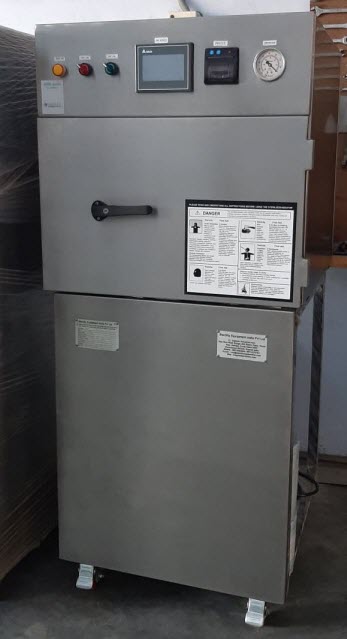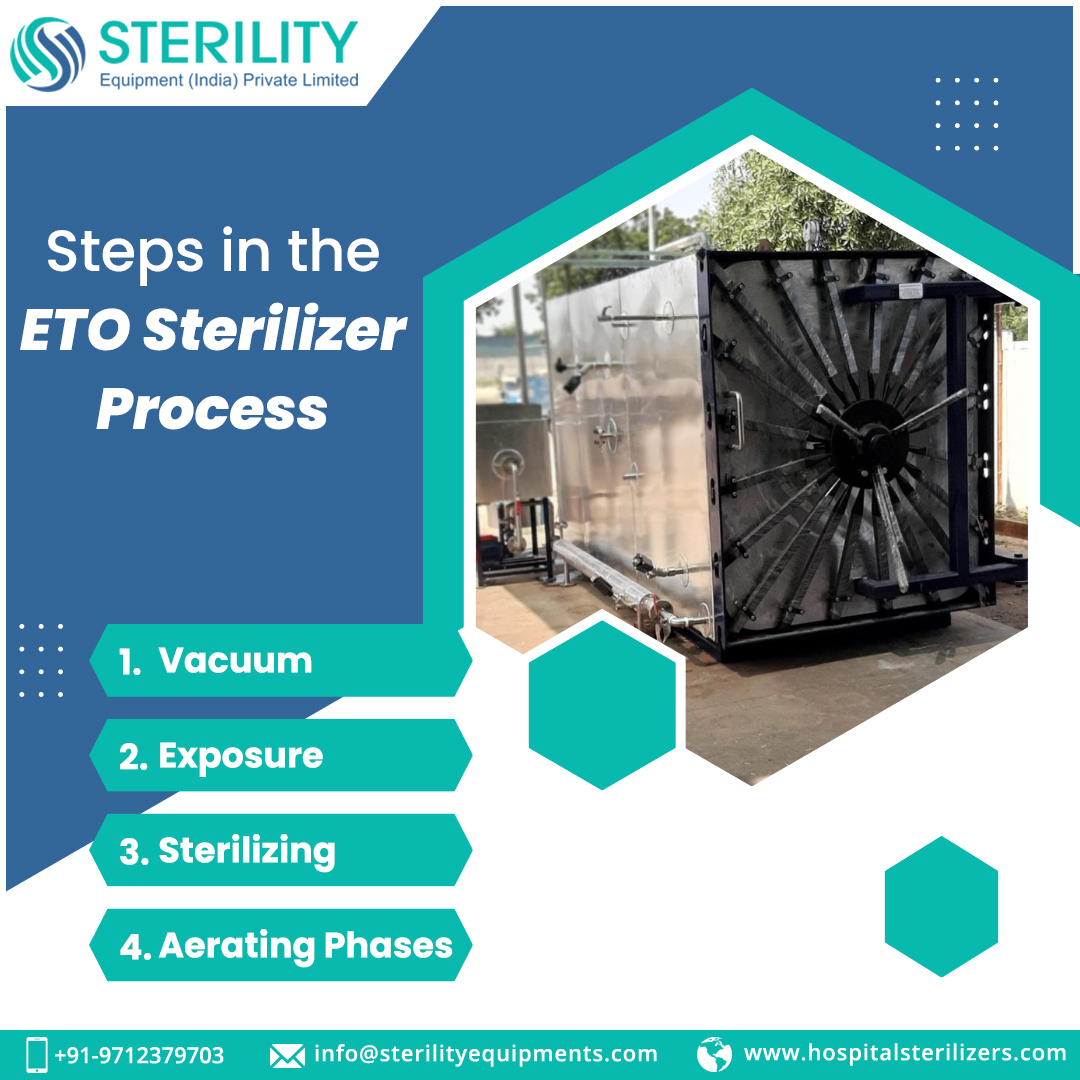Sterilizers use Ethylene Oxide to ensure highly effective disinfection, capable of eliminating even the most resilient pathogens. The advanced technology employed by ETO sterilizers allows for superior disinfection, providing a safer environment for healthcare settings and beyond. Embracing this cutting-edge technology is crucial in preventing infections and maintaining a hygienic environment to safeguard the health of individuals and communities.
How ETO Sterilizers Eradicate Infections?
ETO (Ethylene Oxide) sterilizers are highly effective in eradicating infections due to their unique and precise mechanism. When delving into the science behind ETO sterilizers, it becomes evident how they efficiently eliminate harmful microbes.
The process begins with the penetration of Ethylene Oxide into medical equipment. This gas has remarkable properties that allow it to diffuse through various materials and hard-to-reach areas, ensuring comprehensive disinfection. As Ethylene Oxide permeates the surfaces of the equipment, it comes into contact with microorganisms.
What sets ETO sterilization apart is its ability to target microbes at a molecular level. Ethylene Oxide reacts with cell components, disrupting vital cellular functions, and causing irreparable damage to the microorganisms. This molecular disruption renders the microbes unable to multiply and infect.
Moreover, ETO sterilization is not limited to a specific range of microorganisms; it effectively destroys bacteria, viruses, spores, and other pathogens. This broad spectrum of activity makes it an ideal choice for infection prevention in various healthcare settings.

ETO Sterilizers Revolutionizing Healthcare Hygiene in China
ETO sterilizers are spearheading a revolution in healthcare hygiene in China, bringing about transformative changes in infection control. Embracing this advanced sterilization method, China is witnessing a significant impact on various sectors, from hospitals to pharmaceutical industries.
In hospitals across the country, ETO sterilization has become a cornerstone in preventing healthcare-associated infections (HAIs). The sterilization process ensures that medical equipment and instruments are thoroughly disinfected, eliminating harmful pathogens and reducing the risk of cross-contamination.
Pharmaceutical industries in China have also recognized the importance of ETO sterilization in maintaining product safety and quality. With precise and effective disinfection capabilities, ETO sterilizers play a crucial role in ensuring the integrity of pharmaceutical products, protecting both patients and the reputation of pharmaceutical companies.
The adoption of ETO sterilization in China has contributed to the overall improvement of public health. By curbing the spread of infections and enhancing hygiene standards, the nation moves towards a healthier future.
To keep pace with the advancements in infection control, China consistently updates its healthcare protocols and regulations. The government, along with healthcare institutions, remains committed to staying at the forefront of technology and research to combat infectious diseases effectively.
Guidelines for ETO Sterilizer Usage
When using ETO sterilizers, it is crucial to adhere to safety guidelines and regulations to ensure a safe and effective sterilization process. Familiarize yourself with the relevant safety regulations and guidelines set forth by regulatory authorities. Ensure that your facility meets all the required safety standards before operating the ETO sterilizer.
Provide comprehensive training to personnel responsible for operating the ETO sterilizer. Properly certified staff should handle the equipment to minimize risks and ensure proper sterilization procedures.
Maintain a well-ventilated sterilization area and install gas monitoring systems to constantly monitor Ethylene Oxide levels. Regularly check for gas leaks to prevent exposure to harmful gases.
Regularly inspect the ETO sterilizer and associated equipment for any signs of wear or damage. Address any issues promptly to prevent equipment malfunction and ensure consistent sterilization efficacy. Verify that the items to be sterilized are compatible with ETO sterilization. Some sensitive materials may not withstand the process and require alternative sterilization methods.
Properly package and load items into the sterilizer according to the manufacturer’s guidelines. Ensure adequate spacing between items to allow for proper gas diffusion. After the sterilization cycle, allow sufficient aeration time to remove residual Ethylene Oxide gas. Off-gassing chambers or aeration rooms equipped with ventilation should be used for this purpose.
Develop a comprehensive emergency plan to handle any accidents or gas leak incidents. This plan should include evacuation procedures and contact information for emergency services.
Schedule regular maintenance for the ETO sterilizer, including calibration of temperature and pressure sensors. A well-maintained sterilizer ensures consistent and reliable performance. Keep Safety Data Sheets (SDS) for Ethylene Oxide readily accessible to all staff members. SDS provides essential safety information and emergency response procedures.
The Future of Infection Control ETO Sterilizers at the Forefront
The future of infection control is bright with ETO sterilizers at the forefront of transformative advancements. As technology continues to evolve, ETO sterilizers are poised to bring even better sterilization outcomes and revolutionize healthcare practices.
The future holds the promise of eco-friendly ETO sterilization solutions. Research and development efforts focus on reducing the environmental impact of the process. Green alternatives and sustainable practices will emerge, ensuring infection control without compromising ecological responsibility.
Advancements in material science will broaden the range of devices compatible with ETO sterilization. Delicate and intricate medical instruments, previously challenging to sterilize, will benefit from this process. ETO sterilizers will become more versatile, catering to diverse applications in medical and non-medical fields.
Diverse Applications & Industries
ETO sterilizers demonstrate their versatility by extending their applications beyond the healthcare sector, reaching diverse industries where enhanced safety and quality assurance are paramount.
In the food processing industry, ETO sterilization plays a crucial role in ensuring food safety. It effectively eliminates pathogens, bacteria, and molds from packaging materials, equipment, and even spices. This process prevents foodborne illnesses and maintains the integrity of food products throughout the supply chain.
Pharmaceutical companies rely on ETO sterilization to safeguard the quality and efficacy of their products. The process sterilizes packaging materials, vials, and medical devices, maintaining the sterility of drugs and preventing contamination. With ETO sterilization, pharmaceutical industries can confidently deliver safe and reliable medications to patients.
ETO sterilization finds application in the cosmetic and personal care industry. It ensures that products like creams, lotions, and powders remain free from harmful microorganisms, extending their shelf life and guaranteeing consumer safety.
In the electronics industry, ETO sterilization ensures the safe handling of sensitive electronic components. It eliminates static charges that could damage delicate circuitry and effectively sterilizes packaging materials, protecting electronic devices from contamination during transport and storage.
Aerospace companies utilize ETO sterilization to maintain the integrity of critical equipment used in space exploration and aircraft manufacturing. By sterilizing components and materials, ETO ensures that space instruments and aircraft parts remain free from harmful microbes, contributing to the safety and reliability of aerospace technology.
In research and laboratory settings, ETO sterilization is employed to disinfect glassware, petri dishes and another laboratory equipment. This sterile environment ensures accurate and uncontaminated experimental results, contributing to the reliability of scientific research.
ETO sterilization proves beneficial in the textile industry to ensure the cleanliness of fabrics and garments. By eliminating bacteria and allergens, it enhances the hygiene of clothing and textiles used in sensitive environments, such as medical facilities and clean rooms.
ETO sterilization is employed to ensure the safety of herbs and spices, eradicating harmful microorganisms while preserving their natural flavors and medicinal properties. This process guarantees that consumers can enjoy these products without any health concerns.






